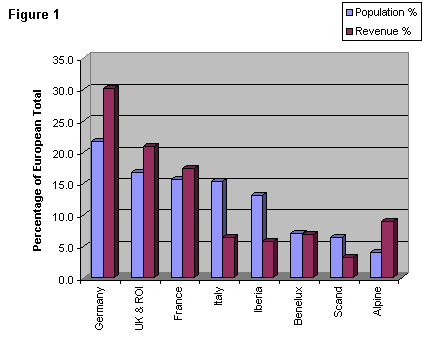|
|
 |
 |
 |
 |
 |
 |
 |
 |
 |
 |
 |
|

Published: Thursday, 14 June 2001 - Presse Release
Opportunities for Growth in Water Treatment Equipment Sales
Revenues |
|
Health conscious consumers are helping drive the sale of residential water treatment equipment forward at a time when the market is facing more challenges than ever before.
Latest research from water analysts Frost & Sullivan (http://water.frost.com) valued the European market at $318.7 million - an estimated 4.4 million water treatment units – in 2000.
This rise has come about despite steady increases in the quality of tap water, driven by national and European legislation, as well as rising rates of domestic connection to mains water supplies. These factors have led to increased public confidence in tap water across Europe.
Environmental Research Analyst Galit Hart explains the forward move: "As consumers become more health conscious, they have been paying more attention to publicity regarding health scares. Increasing consumer knowledge regarding local or national water quality issues is raising awareness of water treatment products, especially those aimed at drinking water applications.
"In this climate of increased consumer awareness, it is becoming easier to sell systems, because potential consumers can more clearly understand the need for this type of equipment. However, raising awareness is an on-going process and there is still a way to go before residential water treatment equipment in general becomes a genuinely commonplace mass-market product."
The market has been restrained due to competition with the bottled water market in some countries. However, the study found there should still be room for the residential water treatment equipment market to expand in countries which traditionally prefer bottled water.
"Bottled water has long been a large market in Europe," Miss Hart continues. "There is a reluctance on the part of consumers to change established routines and install a residential water treatment system, especially in countries which arguably have a greater need due to areas of lower quality mains water then generally found in Europe, such as Italy and Spain.
"The Italian and Iberian (Spain and Portugal) markets rank amongst largest in Europe in terms of population and in addition, in some regions water as supplied to households is of a lower quality then most other European countries. In the face of this, these countries would appear to be ideal markets in terms of demand for such equipment. In reality, these markets generate small revenues in comparison to other countries with similar populations (please see the attached revenue figure)."
"A lot of work needs to be done in many segments of the residential water treatment equipment market in order to convince potential customers of the merits of this type of equipment. The main issue that will need to be addressed by companies in developing marketing strategies is how to justify to the customer why they need to spend potentially large sums of money on water treatment equipment.
"One strategy followed by manufacturers is the tailoring of products to create higher customer satisfaction. Customers residential water treatment equipment needs to vary on a local and/or national basis and for this reason, local or nationally based manufacturers are better placed to produce equipment which caters more to the local needs and preferences. International companies need to put effort into developing products that are tailored to consumer needs in their newer markets.
The study looked at all types of equipment used to treat water at its point of use or point of entry in domestic residences, as well as boats and mobile homes. The market is broken up into five segments: pour-through equipment, counter-top units, purification systems, softening equipment, and physical conditioning equipment.
The European residential softening equipment market generated the largest revenues in the total residential water treatment equipment market with an estimated 41.2 percent share in 2000. This segment is expected to decline in importance over the forecast period and is expected to generate 34.9 percent of revenues in 2007.
The study found the physical conditioning equipment market was one of the fastest growing, with revenues leaping from $52.1 million in 1997 to $69.7 million in 2000. This fast growth in the market has been largely fuelled by growth in the United Kingdom and Republic of Ireland market. Frost & Sullivan forecasts this growth will continue, fuelled by increasing sales in different countries/regions during various times in the forecast period.
Another market expected to increase in importance in the future is the pour-through market: fourth largest in 2000 generating 11.8 percent of the total revenues.
Frost & Sullivan is an international marketing consulting company that monitors a comprehensive spectrum of water markets for trends, market measurements and strategies. This on-going research is utilised to complement a series of research publications to support industry participants with customised consulting needs.
Report Code: 3967, Publication Date: June 2001
For more information contact:
Nikki Cole
nikki.cole@fs-europe.com
Tel. +44 (0) 20 7343 8325
http://water.frost.com
|
|
 |
 |
 |
 |
 |
 |
 |
 |
 |
 |
|


